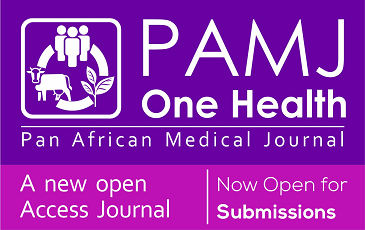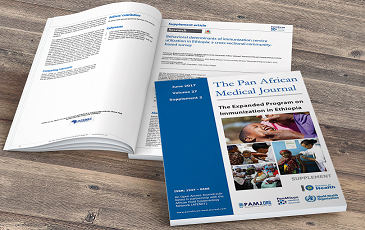Bilateral posterior shoulder fracture dislocation treated by proximal humeral nail: a case report
El Bachir Mghabar, Kabwe Chipalo, Mouad Miloudi, Rachid Alaoui Hachimi, Hatim Abid, Mohammed El Idrissi, Abdelmajid El Mrini
Corresponding author: El Bachir Mghabar, Department of Traumatology and Orthopaedic Surgery, CHU Hassan II, Fez, Morocco 
Received: 24 Feb 2025 - Accepted: 24 Mar 2025 - Published: 04 Apr 2025
Domain: Orthopedic surgery
Keywords: Case report, shoulder, posterior, dislocation, Reverse Hill-Sachs lesion
©El Bachir Mghabar et al. PAMJ Clinical Medicine (ISSN: 2707-2797). This is an Open Access article distributed under the terms of the Creative Commons Attribution International 4.0 License (https://creativecommons.org/licenses/by/4.0/), which permits unrestricted use, distribution, and reproduction in any medium, provided the original work is properly cited.
Cite this article: El Bachir Mghabar et al. Bilateral posterior shoulder fracture dislocation treated by proximal humeral nail: a case report. PAMJ Clinical Medicine. 2025;17:32. [doi: 10.11604/pamj-cm.2025.17.32.47014]
Available online at: https://www.clinical-medicine.panafrican-med-journal.com//content/article/17/32/full
Case report 
Bilateral posterior shoulder fracture dislocation treated by proximal humeral nail: a case report
Bilateral posterior shoulder fracture dislocation treated by proximal humeral nail: a case report
El Bachir Mghabar1,&, Kabwe Chipalo1, Mouad Miloudi1, Rachid Alaoui Hachimi1, Hatim Abid1, Mohammed El Idrissi1, Abdelmajid El Mrini1
&Corresponding author
Bilateral posterior fracture shoulder dislocations are a rare occurrence and as a result are often misdiagnosed. This often leads to late management of these fractures, which compromises their functional outcomes. Their management is subject to controversy, and many different non-surgical and surgical techniques have been described in the literature. These techniques range from conservative to non-conservative treatments. We report a case of a bilateral posterior shoulder fracture dislocation in an elderly patient that was treated by intramedullary proximal humerus nailing and reinsertion of the tuberosities using Boileau´s technique. Intensive physiotherapy was then administered, resulting in a favorable functional outcome at one-year follow-up. We conclude that posterior fracture shoulder dislocations with Reverse Hills-Sachs lesions can be treated conservatively and should not always lead to shoulder arthroplasty.
Bilateral posterior shoulder dislocations are an extremely rare occurrence and represent 5 to 15% of all posterior shoulder dislocations [1]. They are often caused by either epileptic seizures, which are the most common cause, or direct shoulder trauma after a fall on an outstretched hand or a road traffic accident [1,2]. Clinically, the patients present most commonly with shoulder pain, the arm in internal rotation, adduction, and an inability to perform passive or active external rotation [3]. Posterior shoulder dislocations frequently lead to an anterior impaction fracture of the humeral head, which is called a « Reverse Hills-Sachs Lesion » [1]. The size of this lesion is an important determining factor in the treatment choice [4]. We report the case of a 63-year-old man who presented to the emergency department with severe bilateral shoulder pain after sustaining a fall in his home.
Patient information: a 63-year-old man, who is a shopkeeper by profession with no significant medical history, presented to the emergency department for severe bilateral shoulder pain after sustaining a fall in his home. The initial examination showed deformity of both shoulders, swelling, absence of ecchymosis, and intact skin.
Clinical findings: on palpation, tenderness of both shoulders was observed. The patient had a limited range of motion of both shoulders, and he was unable to externally rotate his shoulders or raise his arms. The patient had a full range of motion in both elbows, wrists, and hands, and his neurovascular examination was intact.
Diagnostic assessment: shoulder X-rays, AP and lateral views (Figure 1, Figure 2) were performed, which showed bilateral posterior shoulder 3-part fracture dislocations with a greater comminution on the right compared to the left side. CT scans obtained (Figure 3) confirmed the aforementioned diagnosis and further showed a nondisplaced fracture of the left acromion with a Rockwood type I acromioclavicular joint dislocation. The CT scans also allowed us to observe bilateral reverse Hill-Sachs lesions. A decision was then made for the patient to undergo bilateral open reduction and proximal humeral nailing for both fractures.
Therapeutic intervention: the surgical interventions were performed a day after the admission of the patient, allowing enough time for standard pre-operative examinations and surgical planning. Under general anesthesia in a beach chair position. A transdeltoid lateral approach was used, allowing for reduction of the dislocations and fractures, and then the standard procedure for proximal humeral intramedullary nailing was then followed. The greater and lesser tuberosities, as well as the subscapularis tendons, were then reinserted with smart loops using Boileau´s technique. The intraoperative testing showed that both shoulders were stable. Both shoulders were operated on consecutively with the same technique, and the surgical intervention lasted 2.5 hours with minimal blood loss. The post operative radiographs (Figure 4, Figure 5) showed a good reduction of both shoulder fracture dislocations with congruent glenohumeral joints.
Follow-up and outcome: the patient was immobilised post operatively in shoulder slings and passive physiotherapy was debuted after 15 days, giving sufficient time for soft tissue healing. The patient was then seen at 3 weeks post operatively, he showed good wound healing and no displacement of the fractures. Active mobilisation of the shoulder was debuted 1 month post operatively. At 2 months post operative review, consolidation of both fractures was observed with the patient still undergoing physiotherapy. At 6 months post operative review, the patient showed good functional results with 90° anterior elevation, 80° abduction, 20° external and 20° internal rotation for the right shoulder. The left shoulder presented 100° anterior elevation, 80° abduction, 20° external, and 20° internal rotation. In addition, the patient had no pain when mobilising his shoulders, and he had returned to his daily job as a shopkeeper. The Quick Dash score at the one-year post-operative review was 18/55, and the plain radiographs showed no signs of avascular necrosis (Figure 6, Figure 7 ).
Patient satisfaction: overall, the patient was satisfied with the outcome of the treatment and was able to return to his daily activity as a shopkeeper after 6 months with minimal residual pain and no handicap to his work.
Informed consent: written informed consent was obtained from the patient to publish their case report anonymously.
Bilateral posterior fracture dislocations of the shoulder are an extremely rare occurrence, and not many cases have been reported in the literature [5]. Due to their rarity, they can easily be misdiagnosed in the emergency ward, even when AP and lateral X-ray imaging is available [3]. The axillary view is the most effective view to identify posterior shoulder dislocations, however, this view is difficult to obtain because it requires the patient to perform abduction of the arm, which is almost impossible to do in a patient experiencing pain. It is universally agreed that the CT scan is a necessary examination to diagnose and plan management of a posterior shoulder fracture dislocation [5]. In our case, the bilateral posterior fracture dislocation was diagnosed by simple X-ray imaging, but we performed a CT scan in order to decide and plan the management. These dislocations are notorious for causing other injuries to the shoulder, such as fractures and rotator cuff tears [1]. The CT scan helps evaluate the humeral head in such cases [3]. Kowalsky et al. reported that a Reverse Hill-Sachs lesion of more than 20 to 25% and a subacute dislocation require an open reduction because of the increased risk of avascular necrosis of the humeral head [6]. Humeral defects of less than 25% showed good results with closed reduction performed under general anesthesia [3].
There is no standardisation on the management of these types of fractures because of their low incidence and the lack of several published studies [4]. Several mini-invasive treatment techniques, such as closed reduction and percutaneous pinning, have been described in the literature with good results [7]. Several other authors have used conservative treatments based on McLaughlin´s technique for correction of the Reverse Hill-Sachs lesion and have obtained good results. McLaughlin described a technique in 1952 where he detached and transferred the subscapularis tendon from the lesser tuberosity to the bony defect [8]. We used a technique described by Boileau, in which he fixed the greater and lesser tuberosities after reducing and nailing three and four-part proximal humerus fractures [9]. Open reduction and internal fixation (ORIF) with the use of proximal humerus plates and screws has shown good results in some studies [3]. It is widely recommended to do a hemiarthroplasty or total shoulder arthroplasty for patients with multipart fractures or fractures involving more than 40% of the articular surface due to the high risk of avascular necrosis [10].
Bilateral posterior fracture dislocations are a rare entity, there are no clear management guidelines for these fractures, however, it is universally accepted that the treatment method chosen must address the Reverse Hill-Sachs lesion, which is a common lesion in these fractures. Long term follow up is required in these fractures because of the increased risk of avascular necrosis of the humeral head. In our case, we conclude that intramedullary nailing of these fractures is a viable therapeutic option with which one can obtain good radiological and functional results.
The authors declare no competing interests.
El Bachir Mghabar and Kabwe Chipalo were responsible for patient management, data collection and drafting the original manuscript. Mouad Miloudi, Rachid Alaoui Hachimi, Hatim Abid, Mohammed El Idrissi and Abdelmajid El Mrini were responsible for editing and reviewing the manuscript. All the authors have read and approved the final version of the manuscript.
Figure 1: pre operative X-ray of right shoulder
Figure 2: pre operative X-ray of left shoulder
Figure 3: pre operative CT scan of right shoulder
Figure 4: immediate post operative X-ray of right shoulder
Figure 5: immediate post operative X-ray of left shoulder
Figure 6: X-ray of right shoulder at 9 months post op
Figure 7: X-ray of left shoulder at 9 months post op
- Rouleau DM, Herbert-Davies J. Incidence of associated injury in posterior shoulder dislocation. J Orthop Trauma. 2012 Apr;26(4):246-51. PubMed | Google Scholar
- Basal O, Dincer R, Turk B. Locked posterior dislocation of the shoulder: a systematic review. EFORT Open Rev. 2018 Jan 15;3(1):15-23. PubMed | Google Scholar
- Schumacher KM, Moravec A, Jonas ME, Tayag DL, Choi JY. Bilateral posterior shoulder fracture dislocations from seizures due to hyponatremia: a case report. JSES Rev Rep Tech. 2022 Oct 30;3(1):94-100. PubMed | Google Scholar
- Cooke SJ, Hackney RG. Bilateral posterior four-part fracture–dislocations of the shoulders following electric shock: A case report and literature review. Injury Extra. 2005 Apr 1;36(4):90-5. Google Scholar
- Mnif H, Koubaa M, Zrig M, Zrour S, Amara K, Bergaoui N et al. Bilateral posterior fracture dislocation of the shoulder. Chir Main. 2010 Apr;29(2):132-4. PubMed
- Kowalsky MS, Levine WN. Traumatic posterior gleno-humeral dislocation: classification, pathoanatomy, diagnosis and treatment. Orthop Clin NAm. 2008;39(4):519-533. PubMed | Google Scholar
- Aparicio G, Calvo E, Bonilla L, Espejo L, Box R. Neglected traumatic posterior dislocations of the shoulder: controversies on indications for treatment and new CT scan findings. J Orthop Sci. 2000;5(1):37-42. PubMed | Google Scholar
- McLAUGHLIN HL. Posterior dislocation of the shoulder. J Bone Joint Surg Am. 1952 Jul;24 A(3):584-90. PubMed | Google Scholar
- Sears BW, Johnston PS, Garrigues GE, Boileau P, Hatzidakis AM. Intramedullary nailing of the proximal humerus—not just for 2-part fractures. Ann Joint. 2020;5:32. Google Scholar
- Morán N, Marsalli M, Vargas M, De la Paz J, Cartaya M. Good functional results with open reduction and internal fixation for locked posterior shoulder fracture-dislocation: a case series. Clin Shoulder Elb. 2022 Dec;25(4):288-295. PubMed | Google Scholar











